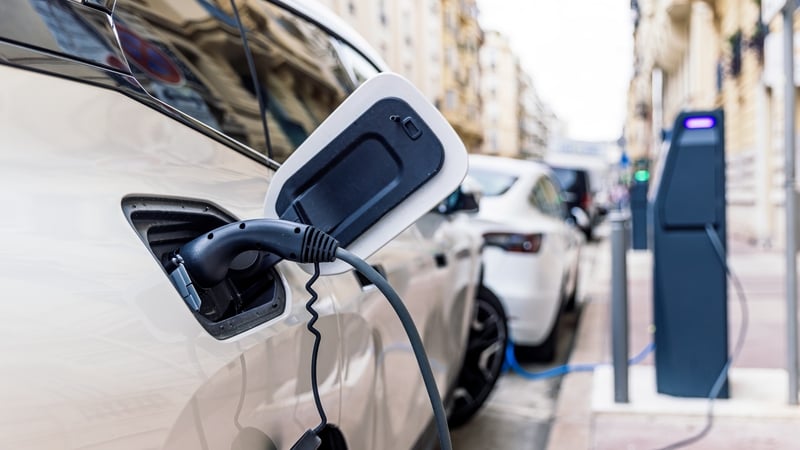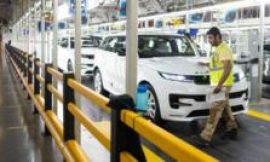Analysis: Despite the big push to get drivers into electric cars, there are still many challenges with the Irish charging infrastructure
The Government’s National Road Network Plan 2024-2030 sets a 30% target for electric power of the national fleet and a 50% cut in transport emissions by 2030. The Department of Transport’s ZEVI office is tasked with leading and coordinating the infrastructural roll out. The EU’s Alternative Fuel Infrastructure Regulation mandates that sufficient power capacity be provided based on the size of the national registered fleet, including passenger EVs. This includes installation of fast-charging stations for cars and vans at 60km intervals on principal highway routes.
We need your consent to load this rte-player contentWe use rte-player to manage extra content that can set cookies on your device and collect data about your activity. Please review their details and accept them to load the content.Manage Preferences
From RTÉ News in Oct 2024, Dublin’s four local authorities are rolling out 200 electric vehicle chargers that will increase the number of public power points in the capital by 50%
Recent figures from the Society of the Irish Motoring Industry (SIMI) indicate that momentum is building in the transition from petrol and diesel engines to hybrid and full electric vehicles. There has been a significant rise in the registration of both hybrid and full-electric vehicles in 2025, with an average increase of 69% for the months of June, July and August, to that of 2024. While this shows a growing trend in changing to electric vehicles, there is still a degree of anxiety with principal concerns including vehicle purchase price, kilometer range and sufficiency/reliability in public charging stations.
In terms of EV support provision from the Government, Budget 2026 featured an extension of vehicle registration tax (VRT) relief, to a maximum of €5000; a purchase grant of €3,500; and a €300 home charger grant. When available, home charging remains the most popular way to charge for EV owners.

While the number of public charging points across Ireland was relatively low up to 2023, there has been a step improvement in the interim two years, with more than 2,500 recorded to date. The ESB leads the way, accounting for 1,600 charging stations. Other charge point operators include Applegreen Electric, Tesla, EZO (formerly Easygo), Circle K and Ionity.
There are three different types of chargers at locations across the network: Type 2 port, CCS port, and CHAdeMO port.


A Type 2 charging port is a standard cable supplied with the EV, and is suitable for home charging. It is estimated that 80% of charging is performed at the EV owners’ place of residence. It is beneficial to install a smart charger if the home has been equipped with PV solar panels. With three charge mode facilities, eco, eco+ and fast charge, this provides for regular, inexpensive charging of your electric car.
Eco uses a combination of renewable energy and grid power to charge the vehicle, whilst limiting overuse of available renewable energy. Eco+ uses renewable energy only. This is beneficial on days when there is plentiful solar energy supply and there is no urgency of requirement to use the vehicle. Reduced night-boost rate electricity purchase from the grid is also beneficial, with current Electric Ireland unit price rates of € 0.0965 between 2am and 4am. Having been plugged in earlier in the evening, the charger is set to energise (in fast mode) in the allotted two-hour period.
We need your consent to load this rte-player contentWe use rte-player to manage extra content that can set cookies on your device and collect data about your activity. Please review their details and accept them to load the content.Manage Preferences
From RTÉ Radio 1’s Today with Claire Byrne, could BYD’s five minute charger be a game changer for EVs?
The ESB public charge point rate for use of a fast charger (CCS) is €0.64 W/kWh, reduced to €0.59 for those registered via the app. The rate for use of a high power (CHAdeMO) charger is €0.66 W/kWh, reduced to 0.61 W/kWh via the app.
The National Road Network Plan document provides mappings, with 5,300 km of primary and secondary roads across Ireland, combined with assessment of location requirement and the potential for charger installation to meet emerging and future requirements. Planning and implementation is led by ZEVI with stakeholders including Transport Infrastructure Ireland, local authorities, energy providers and other contributing companies. Coordination and linkage with the European Union is vital to the success of the long-term plan as Ireland is a constituent partner to the Trans European Transport (Ten-T) network of roads, railways, airports and ports.
We need your consent to load this rte-player contentWe use rte-player to manage extra content that can set cookies on your device and collect data about your activity. Please review their details and accept them to load the content.Manage Preferences
From RTÉ Radio 1’s Drivetime, where are the best places for EV charging points?
Focus is on charging requirements of light-duty electric vehicles, including passenger electric cars, and heavy-duty vehicles. Ireland may also benefit through innovation and methodology exchange with nation partners, including Germany, France, Holland and Denmark. In Düsseldorf, ground-level kerb chargers have been installed in place of traditional upright chargers. This innovation could be very beneficial where space is a premium, such as in residential apartment complexes or streets with on-street parking.
Much frustration has been expressed and experienced by those trying to access public charge points. For EV owners who do not have off-street parking, regular recharge accessibility can be problematic, and stressful.
We need your consent to load this rte-player contentWe use rte-player to manage extra content that can set cookies on your device and collect data about your activity. Please review their details and accept them to load the content.Manage Preferences
From RTÉ News, a number of residents in the Adamstown area of west Dublin have been told that EV chargers they have installed in front of their homes will be removed because parking spaces and pathways in the development are regarded as common areas.
The Dutch approach and methodology in tackling urban charger requirements is impressively client and community centric. Cooperative linkage between agencies responsible for implementation, including energy supply authorities, charger manufacturers and installation contractors, makes for positive attainment in short periods of time.
Citizens are invited to make application for their home or on behalf of their local community, which is well received and followed up by teams to assess feasibility. If such facilitation were adopted for urban and rural settings in Ireland, confidence levels would rise, and more people would make the change to full electric and plug-in hybrid vehicles.
Follow RTÉ Brainstorm on WhatsApp and Instagram for more stories and updates
The views expressed here are those of the author and do not represent or reflect the views of RTÉ




